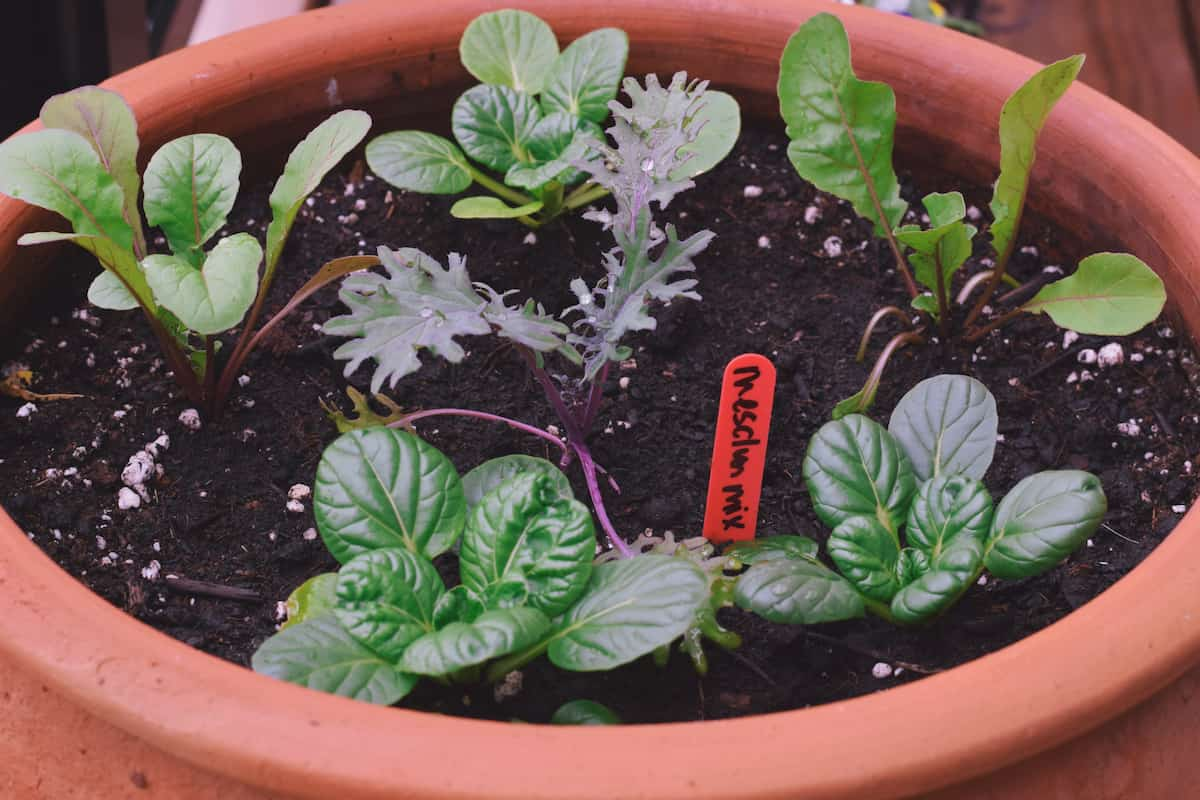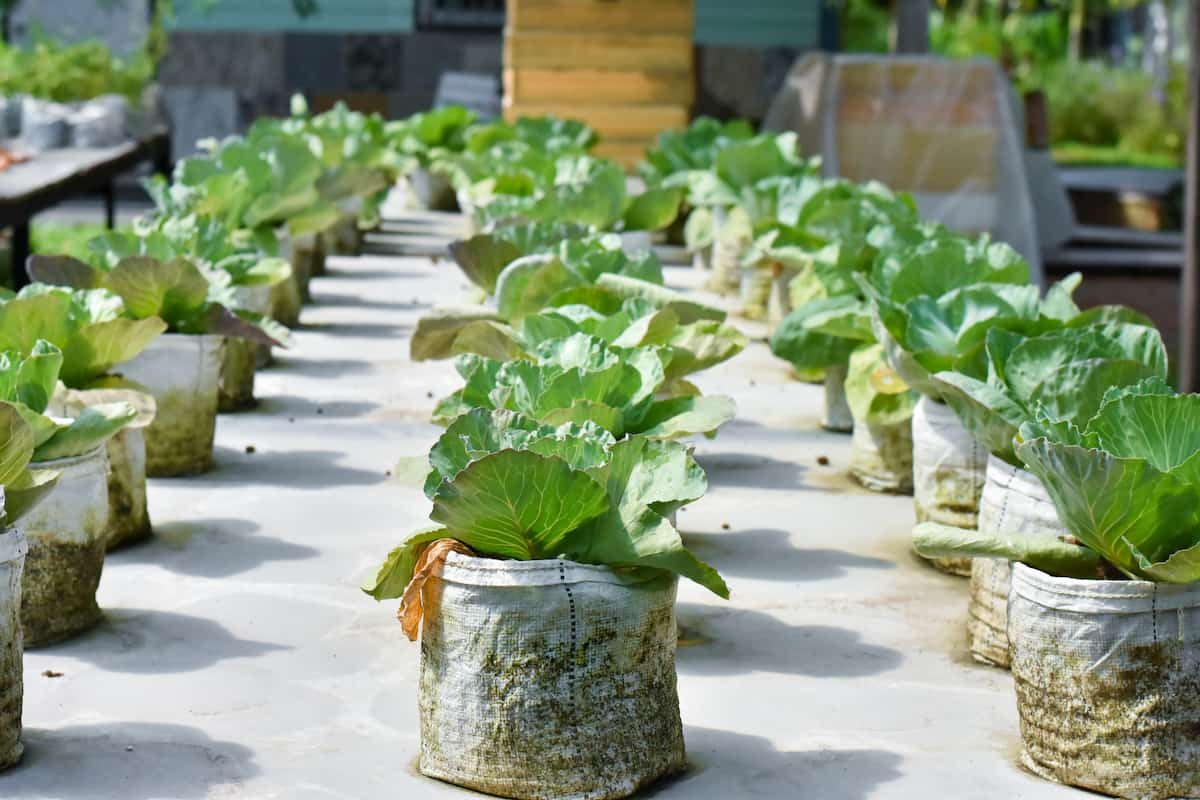Container gardening is an excellent way to grow fresh, organic vegetables in a limited space. This guide will provide a comprehensive overview of creating an organic container vegetable garden from scratch for beginners, ensuring you have a successful and bountiful harvest. Following these steps, you can enjoy fresh, homegrown produce even with limited outdoor space.

Guide to Start an Organic Container/Pot Vegetable Garden
Choose the Right Containers
The first step in creating an organic vegetable garden is selecting the right containers. Choose pots made from natural, porous materials such as terracotta, wood, or fabric. These materials will allow for better air circulation and drainage, crucial for healthy plant growth. Ensure the containers have adequate drainage holes to prevent waterlogging and root rot. Size is also important; select deep and wide pots to accommodate the specific vegetable varieties you wish to grow.
Select High-Quality Organic Soil
For a successful container vegetable garden, use high-quality organic potting soil. This soil should be rich in nutrients, well-draining, and free from contaminants such as synthetic fertilizers, pesticides, or herbicides. Organic potting soil mixtures often combine peat moss, coco coir, compost, vermiculite, and perlite. You can also make your own organic potting mix by combining equal parts compost, peat moss or coco coir, and perlite or vermiculite.
Choose the Right Vegetables
Not all vegetables are suitable for container gardening. Select varieties are known to perform well in pots, such as dwarf or bush varieties. Some popular vegetables for container gardening include tomatoes, peppers, eggplants, cucumbers, lettuce, radishes, carrots, beets, and herbs. Research each vegetable’s specific growing requirements, such as sunlight, water, and space, to ensure you can provide optimal growing conditions.
Planting Your Vegetables
Once you have chosen your containers, soil, and vegetables, it’s time to start planting. Fill your containers with the organic potting mix, leaving an inch or two at the top for watering. Plant seeds or seedlings according to the package instructions, ensuring each plant has enough room to grow. Be mindful of companion planting, as some vegetables thrive when planted near certain other plants, while others may inhibit growth. If you are planting multiple vegetables in one container, choose compatible plants.
Watering Your Container Garden
Adaaqute watering is essential for the health and productivity of your container vegetable garden. Containers can dry out quickly, so it’s necessary to track the moisture levels of your soil regularly. Water your plants thoroughly when the top inch of the soil feels dry. A watering can with a fine rose attachment or a gentle shower setting on a hose help distribute water evenly without disturbing the soil.
In case you missed it: Ultimate Guide to Start an Organic Vegetable Terrace Garden: Creating from Scratch for Planting to Harvest

Fertilizing Your Garden
Organic container gardens require regular feeding to maintain nutrient levels in the soil. Use a high-quality organic fertilizer, such as compost tea, fish emulsion, or worm castings, to provide essential nutrients for your plants. Apply the fertilizer according to the package instructions, typically every 4 to 6 weeks throughout the growing season. You can also include a slow-release organic fertilizer to your potting mix at planting time to provide a steady supply of nutrients.
Sunlight and Temperature
Most vegetables require full sun, which means at least 5 to 8 hours of direct sunlight daily. Position your container garden in a location that receives the appropriate sunlight for your growing vegetables. Remember that some plants, such as leafy greens, may benefit from partial shade during the hottest day.
Monitor the temperature, as extreme heat or cold can negatively impact your plants. Consider using shade cloth or moving your containers to a cooler location during heat waves. Conversely, protect your plants from frost by moving them indoors or using frost covers when necessary.
Pest and Disease Management
One of the advantages of container gardening is that it reduces the risk of soil-borne diseases and pests. However, you may still encounter aphids, whiteflies, or fungal infections. Practice preventive measures like proper watering, good air circulation, and removing dead plant material. If you encounter pests or diseases, opt for organic solutions such as insecticidal soap, neem oil, or homemade remedies like garlic or pepper spray.
Supporting Your Plants
Some vegetables, like tomatoes, peppers, and cucumbers, require support as they grow. Use stakes, cages, or trellises to keep your plants upright and to provide adequate airflow. Secure your plants gently with soft ties or cloth strips to prevent damage. As your plants grow, check and adjust the supports regularly to ensure they are stable and effective.
Harvesting Your Vegetables
One of the most rewarding aspects of container gardening is harvesting fresh, organic produce from your own garden. Familiarize yourself with the harvesting guidelines for each vegetable variety you are growing. Harvesting at the right time will ensure the best flavor and nutritional value. Regular harvesting can also promote the continued production of some vegetables, like tomatoes and beans.
End-of-Season Care and Storage
As the growing season comes to an end, it’s essential to care for your containers and soil properly. Remove dead or diseased plant material and dispose of it from your garden. Empty your containers and store them in a dry, cool location to prevent damage from freezing temperatures. Consider composting the used potting soil or adding it to your garden beds to enrich the soil. Clean and sterilize your containers before storing them for the winter or reusing them in the next growing season.
Succession Planting and Crop Rotation
To maximize the productivity of your organic container vegetable garden, consider succession planting and crop rotation. Succession planting involves planting new crops as soon as you harvest the old ones, ensuring a constant supply of fresh produce throughout the growing season.
For example, once you have harvested your spring lettuce, plant a summer crop like beans in the same container. Crop rotation is essential for maintaining soil health and preventing the buildup of pests and diseases. Avoid planting the same family of vegetables in the same container for at least two years.
In case you missed it: How to Start Your Own Organic Garden: A Step-By-Step Creating Guide

Conclusion
Organic container vegetable gardening is a rewarding and sustainable way to grow fresh produce, even in limited spaces. You can enjoy a bountiful harvest from your garden by choosing the right containers, soil, and vegetables and providing proper care.
- Feed Your Flock for Less: Top 10 Tips to Save on Chicken Feed
- Ultimate Guide to Ossabaw Island Hog: Breeding, Raising, Diet, and Care
- Hatching Answers: The Top 10 Reasons Your Chickens Aren’t Laying Eggs
- Eggs and Economics: Breaking Down the Cost of Raising Backyard Chickens
- Defend Your Greens: Proven Methods to Keep Iguanas Out of Your Garden
- Ultimate Guide to Cinnamon Queen Chicken: A Comprehensive Guide for Beginners
- Ultimate Guide to California Tan Chicken: Breeding, Raising, Diet, Egg-Production and Care
- Ultimate Guide to Marsh Daisy Chicken: Breeding, Raising, Diet, and Care
- 10 Types of Chicken Farming Businesses You Can Start for Profits